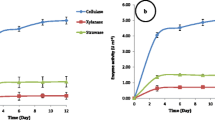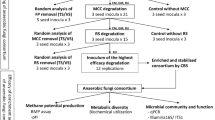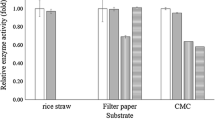Abstract
Acid pretreatment of lignocellulosic biomass releases furan and phenolic compounds, which are toxic to microorganisms used for subsequent fermentation. In this study, we isolated new microorganisms for depletion of inhibitors in lignocellulosic acid hydrolysates. A sequential enrichment strategy was used to isolate microorganisms from soil. Selection was carried out in a defined mineral medium containing a mixture of ferulic acid (5 mM), 5-hydroxymethylfurfural (5-HMF, 15 mM), and furfural (20 mM) as the carbon and energy sources, followed by an additional transfer into a corn stover hydrolysate (CSH) prepared using dilute acid. Subsequently, based on stable growth on these substrates, six isolates—including five bacteria related to Methylobacterium extorquens, Pseudomonas sp, Flavobacterium indologenes, Acinetobacter sp., Arthrobacter aurescens, and one fungus, Coniochaeta ligniaria—were chosen. All six isolates depleted toxic compounds from defined medium, but only C. ligniaria C8 (NRRL 30616) was effective at eliminating furfural and 5-HMF from CSH. C. ligniaria NRRL 30616 may be useful in developing a bioprocess for inhibitor abatement in the conversion of lignocellulosic biomass to fuels and chemicals.





Similar content being viewed by others
References
Ausubel FM, Brent R, Kingston RE, Moore DD, Seidman JG, Smith JA, Struhl K (eds) (1999) Current protocols in molecular biology. Wiley, New York
Beck MJ (1986) Factors affecting efficiency of biomass fermentation to ethanol. Biotechnol Bioeng 17:617–627
Boopathy R, Bokang H, Daniels L (1993) Biotransformation of furfural and 5-hydroxymethylfurfural by enteric bacteria. J Ind Microbiol 11:147–150
Bothast RJ, Saha BC (1997) Ethanol production from agricultural biomass substrates. Adv Appl Microbiol 44:261–286
Bugos RC, Sutherland JB, Adler JH (1988) Phenolic compound utilization by the soft rot fungus Lecythophora hoffmannii. Appl Environ Microbiol 54:1882–1885
Dien BS, Bothast RJ, Nichols NN, Cotta MA (2002) The U.S. corn industry: an overview of current technology and future prospects. Int Sugar J 104:204–211
Esteghlalian A, Hashimoto AG, Fenske JJ, Penner MH (1997) Modeling and optimization of the dilute-sulfuric-acid pretreatment of corn stover, poplar and switchgrass. Bioresour Technol 59:129–136
Gerhardt P, Murray RGE, Wood WA, Krieg NR (eds) (1994) Methods for general and molecular bacteriology. American Society for Microbiology, Washington D.C.
Gong CS, Chen CS, Chen LF (1993) Pretreatment of sugar cane bagasses hemicellulose hydrolyzate for ethanol production by yeast. Appl Biochem Biotechnol 39/40:83–88
Hsu T (1996) Pretreatment of biomass. In: Wyman CE (ed) Handbook on bioethanol: production and utilization. Taylor and Francis, Washington D.C., pp 179–212
Jernberg C, Jansson JK (2002) Impact of 4-chlorophenol contamination and/or inoculation with the 4-chlorophenol-degrading strain, Arthrobacter chlorophenolicus A6L, on soil bacterial community structure. FEMS Microbiol Ecol 42:387–397
Jönsson LJ, Palmqvist E, Nilvebrant N-O, Hahn-Hägerdal B (1998) Detoxification of wood hydrolysates with laccase and peroxidase from the white-rot fungus Trametes versicolor. Appl Microbiol Biotechnol 49:691–697
Kim T, Hah Y, Hong S (1983) Toxic effects of furfural on Pseudomonas fluorescens. Korean J Microbiol 21:149–155
Knupp G, Rücker G, Ramos-Cormenzana A, Garrido-Hoyos S, Neugebauer M, Ossenkop T (1996) Problems of identifying phenolic compounds during the microbial degradation of olive mill wastewater. Int Biodeterior Biodegrad 38:277–282
Koenig K, Andreesen JR (1990) Xanthine dehydrogenase and 2-furoyl-coenzyme A dehydrogenase from Pseudomonas putida Fu1: two molybdenum-containing dehydrogenases of novel structural composition. J Bacteriol 172:5999–6009
Kurtzman CP, Robnett CJ (1998) Identification and phylogeny of ascomycetous yeasts from analysis of nuclear large subunit (26S) ribosomal DNA partial sequences. Antonie van Leeuwenhoek 73:331–371
Larsson S, Palmqvist E, Hahn-Hägerdal B, Tengborg C, Stenberg K, Zacchi G, Nilvebrant, N-O (1999) The generation of fermentation inhibitors during dilute acid hydrolysis of softwood. Enzyme Microb Technol 24:151–159
Luo C, Brink DL, Blanch HW (2001) Identification of potential fermentation inhibitors in conversion of hybrid poplar hydrolyzate to ethanol. Biomass Bioenerg 22:125–138
Martinez A, Rodriguez ME, Wells ML, York SW, Preston JF, Ingram LO (2001) Detoxification of dilute acid hydrolysates of lignocellulose with lime. Biotechnol Prog 17:287–293
Mielenz JR (2001) Ethanol production from biomass: technology and commercial status. Curr Opin Microbiol 4:324–329
Nilsson T (1973) Studies on wood degradation and cellulolytic activity of microfungi. Stud For Suec 104:1–40
Nilvebrant N-O, Reimann A, Larsson S, Jönsson LJ (2001) Detoxification of lignocellulose hydrolysates with ion-exchange resins. Appl Biochem Biotechnol 91/93:35–49
Palmqvist E, Hahn-Hägerdal B (2000) Fermentation of lignocellulosic hydrolysates. II: Inhibitors and mechanisms of inhibition. Bioresour Technol 74:25–33
Palmqvist E, Hahn-Hägerdal B, Szengyel Z, Zacchi G, Rèczey K (1997) Simultaneous detoxification and enzyme production of hemicellulose hydrolysates obtained after steam pretreatment. Enzyme Microb Technol 20:286–293
Paul EA, Clark FE (1996) Soil microbiology and biochemistry, 2nd edn. Academic Press, New York
Rosazza JPN, Huang Z, Dostal L, Volm T, Rousseau B (1995) Biocatalytic transformation of ferulic acid: abundant aromatic natural product. J Ind Microbiol 15:457–471
Saddler JN (ed) (1993) Bioconversion of forest and agricultural plant residues. CAB International, Wallingford, UK
Saeman JF (1945) Kinetics of wood saccharification. Hydrolysis of cellulose and decomposition of sugars in dilute acid at high temperature. Ind Eng Chem 37:43–52
Saha BC, Bothast RJ (1999) Pretreatment and enzymatic saccharification of corn fiber. Appl Biochem Biotechnol 76:65–77
Schneider H (1996) Selective removal of acetic acid from hardwood-spent sulfite liquor using a mutant yeast. Enzyme Microb Technol 19:94–98
Sun Y, Cheng J (2002) Hydrolysis of lignocellulosic materials for ethanol production: a review. Bioresour Technol 83:1–11
Taherzadeh MJ, Gustafsson L, Niklasson C, Lidén G (2000) Physiological effects of 5-hydroxymethylfurfural on Saccharomyces cerevisiae. Appl Microbiol Biotechnol 53:701–708
Wang P, Brenchley JE, Humphrey AE (1994) Screening microorganisms for utilization of furfural and possible intermediates in its degradation pathway. Biotechnol Lett 16:977–982
Weber E, Görke C, Begerow D (2002) The Lecythophora-Coniochaeta complex II. Molecular studies based on sequences of the large subunit of ribosomal DNA. Nova Hedwigia 74:187–200
Whitehead TR, Cotta MA (2001) Characterisation and comparison of microbial populations in swine faeces and manure storage pits by 16S rDNA gene sequence analyses. Anaerobe 7:181–187
Zaldivar J, Martinez A, Ingram LO (1999). Effect of selected aldehydes on the growth and fermentation of ethanologenic Escherichia coli LY01. Biotechnol Bioeng 65:24–33
Zaldivar J, Nielsen J, Olsson L (2001) Fuel ethanol production from lignocellulose: a challenge for metabolic engineering and process integration. Appl Microbiol Biotechnol 56:17–34
Acknowledgements
We wish to thank Dr. Clete Kurtzman and Dr. Donald Wicklow for help identifying fungal strain C8, and Dr. Terrence Whitehead for providing primers for amplification of bacterial rDNA. We thank Ms. Patricia O'Bryan and Mr. Loren Iten for excellent technical assistance, and Dr. Evi Weber for helpful discussion. This work was supported by ARS-USDA through cooperative research agreement 3620-41000-084-03
Author information
Authors and Affiliations
Corresponding author
Additional information
Names are necessary to report factually on available data; however, the USDA neither guarantees nor warrants the standard of the product, and the use of the name by USDA implies no approval of the product to the exclusion of others that may also be suitable
Rights and permissions
About this article
Cite this article
López, M.J., Nichols, N.N., Dien, B.S. et al. Isolation of microorganisms for biological detoxification of lignocellulosic hydrolysates. Appl Microbiol Biotechnol 64, 125–131 (2004). https://doi.org/10.1007/s00253-003-1401-9
Received:
Revised:
Accepted:
Published:
Issue Date:
DOI: https://doi.org/10.1007/s00253-003-1401-9




